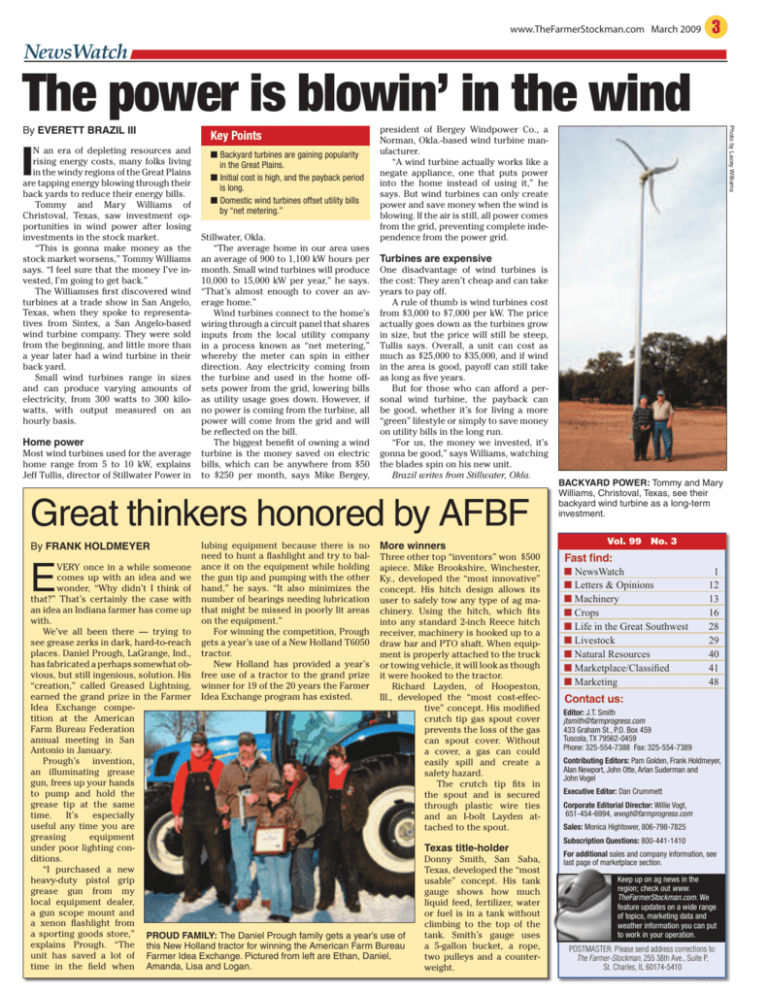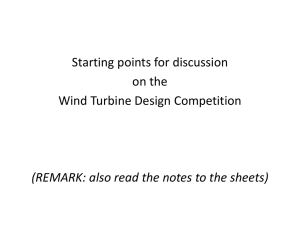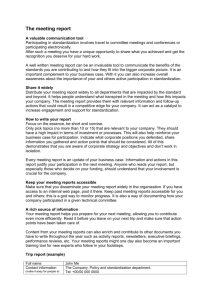The power is blowin' in the wind - Farm Progress Issue Search Engine
advertisement

www.TheFarmerStockman.com March 2009 3 NewsWatch The power is blowin’ in the wind I N an era of depleting resources and rising energy costs, many folks living in the windy regions of the Great Plains are tapping energy blowing through their back yards to reduce their energy bills. Tommy and Mary Williams of Christoval, Texas, saw investment opportunities in wind power after losing investments in the stock market. “This is gonna make money as the stock market worsens,” Tommy Williams says. “I feel sure that the money I’ve invested, I’m going to get back.” The Williamses first discovered wind turbines at a trade show in San Angelo, Texas, when they spoke to representatives from Sintex, a San Angelo-based wind turbine company. They were sold from the beginning, and little more than a year later had a wind turbine in their back yard. Small wind turbines range in sizes and can produce varying amounts of electricity, from 300 watts to 300 kilowatts, with output measured on an hourly basis. Home power Most wind turbines used for the average home range from 5 to 10 kW, explains Jeff Tullis, director of Stillwater Power in Key Points ■ Backyard turbines are gaining popularity in the Great Plains. ■ Initial cost is high, and the payback period is long. ■ Domestic wind turbines offset utility bills by “net metering.” Stillwater, Okla. “The average home in our area uses an average of 900 to 1,100 kW hours per month. Small wind turbines will produce 10,000 to 15,000 kW per year,” he says. “That’s almost enough to cover an average home.” Wind turbines connect to the home’s wiring through a circuit panel that shares inputs from the local utility company in a process known as “net metering,” whereby the meter can spin in either direction. Any electricity coming from the turbine and used in the home offsets power from the grid, lowering bills as utility usage goes down. However, if no power is coming from the turbine, all power will come from the grid and will be reflected on the bill. The biggest benefit of owning a wind turbine is the money saved on electric bills, which can be anywhere from $50 to $250 per month, says Mike Bergey, president of Bergey Windpower Co., a Norman, Okla.-based wind turbine manufacturer. “A wind turbine actually works like a negate appliance, one that puts power into the home instead of using it,” he says. But wind turbines can only create power and save money when the wind is blowing. If the air is still, all power comes from the grid, preventing complete independence from the power grid. Turbines are expensive One disadvantage of wind turbines is the cost: They aren’t cheap and can take years to pay off. A rule of thumb is wind turbines cost from $3,000 to $7,000 per kW. The price actually goes down as the turbines grow in size, but the price will still be steep, Tullis says. Overall, a unit can cost as much as $25,000 to $35,000, and if wind in the area is good, payoff can still take as long as five years. But for those who can afford a personal wind turbine, the payback can be good, whether it’s for living a more “green” lifestyle or simply to save money on utility bills in the long run. “For us, the money we invested, it’s gonna be good,” says Williams, watching the blades spin on his new unit. Brazil writes from Stillwater, Okla. Great thinkers honored by AFBF By FRANK HOLDMEYER E lubing equipment because there is no need to hunt a flashlight and try to balance it on the equipment while holding the gun tip and pumping with the other hand,” he says. “It also minimizes the number of bearings needing lubrication that might be missed in poorly lit areas on the equipment.” For winning the competition, Prough gets a year’s use of a New Holland T6050 tractor. New Holland has provided a year’s free use of a tractor to the grand prize winner for 19 of the 20 years the Farmer Idea Exchange program has existed. Photo by Lacey Williams By EVERETT BRAZIL III More winners Three other top “inventors” won $500 apiece. Mike Brookshire, Winchester, Ky., developed the “most innovative” concept. His hitch design allows its user to safely tow any type of ag machinery. Using the hitch, which fits into any standard 2-inch Reece hitch receiver, machinery is hooked up to a draw bar and PTO shaft. When equipment is properly attached to the truck or towing vehicle, it will look as though it were hooked to the tractor. Richard Layden, of Hoopeston, Ill., developed the “most cost-effective” concept. His modified crutch tip gas spout cover prevents the loss of the gas can spout cover. Without a cover, a gas can could easily spill and create a safety hazard. The crutch tip fits in the spout and is secured through plastic wire ties and an I-bolt Layden attached to the spout. VERY once in a while someone comes up with an idea and we wonder, “Why didn’t I think of that?” That’s certainly the case with an idea an Indiana farmer has come up with. We’ve all been there — trying to see grease zerks in dark, hard-to-reach places. Daniel Prough, LaGrange, Ind., has fabricated a perhaps somewhat obvious, but still ingenious, solution. His “creation,” called Greased Lightning, earned the grand prize in the Farmer Idea Exchange competition at the American Farm Bureau Federation annual meeting in San Antonio in January. Prough’s invention, an illuminating grease gun, frees up your hands to pump and hold the grease tip at the same time. It’s especially useful any time you are greasing equipment under poor lighting conditions. “I purchased a new heavy-duty pistol grip grease gun from my local equipment dealer, a gun scope mount and a xenon flashlight from a sporting goods store,” PROUD FAMILY: The Daniel Prough family gets a year’s use of explains Prough. “The this New Holland tractor for winning the American Farm Bureau unit has saved a lot of Farmer Idea Exchange. Pictured from left are Ethan, Daniel, time in the field when Amanda, Lisa and Logan. Texas title-holder Donny Smith, San Saba, Texas, developed the “most usable” concept. His tank gauge shows how much liquid feed, fertilizer, water or fuel is in a tank without climbing to the top of the tank. Smith’s gauge uses a 5-gallon bucket, a rope, two pulleys and a counterweight. BACKYARD POWER: Tommy and Mary Williams, Christoval, Texas, see their backyard wind turbine as a long-term investment. Vol. 99 No. 3 Fast find: ■ NewsWatch ■ Letters & Opinions ■ Machinery ■ Crops ■ Life in the Great Southwest ■ Livestock ■ Natural Resources ■ Marketplace/Classified ■ Marketing 1 12 13 16 28 29 40 41 48 Contact us: Editor: J.T. Smith jtsmith@farmprogress.com 433 Graham St., P.O. Box 459 Tuscola, TX 79562-0459 Phone: 325-554-7388 Fax: 325-554-7389 Contributing Editors: Pam Golden, Frank Holdmeyer, Alan Newport, John Otte, Arlan Suderman and John Vogel Executive Editor: Dan Crummett Corporate Editorial Director: Willie Vogt, 651-454-6994, wvogt@farmprogress.com Sales: Monica Hightower, 806-798-7825 Subscription Questions: 800-441-1410 For additional sales and company information, see last page of marketplace section. Keep up on ag news in the region; check out www. TheFarmerStockman.com. We feature updates on a wide range of topics, marketing data and weather information you can put to work in your operation. POSTMASTER: Please send address corrections to: The Farmer-Stockman, 255 38th Ave., Suite P, St. Charles, IL 60174-5410








